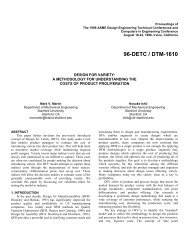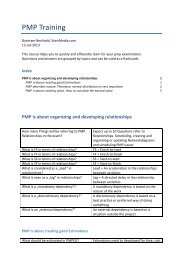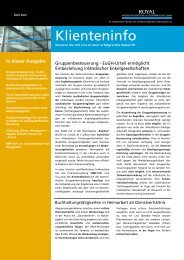Social Marketing
Create successful ePaper yourself
Turn your PDF publications into a flip-book with our unique Google optimized e-Paper software.
<strong>Marketing</strong> Mix 57<br />
Advertising<br />
“decision points” where you can check in to ensure that everything is on track. For example,<br />
you would probably want to see the moderator’s guide before you attended a focus group.<br />
Then you can ensure that the key issues are covered.<br />
You also want to monitor the creation of advertising products, especially more costly and complicated<br />
ones, such as television and radio spots.<br />
There are a number of points where advertising clients can monitor the progress of these<br />
types of products. These are a bit different depending on the product and your time constraints.<br />
In any case, work with your agency to ensure that you are an appropriate part of the entire<br />
creative process.<br />
Types of advertising<br />
Public service announcements<br />
A public service announcement, or PSA, is a TV or radio message<br />
that serves a useful public interest and is offered by a<br />
broadcasting station free-of-charge. However, free doesn’t<br />
mean that there isn’t a price.<br />
How do I run a PSA?<br />
You can produce your own PSA<br />
or you can provide a script for<br />
the station’s own on-air talent<br />
to read. In the United States, some<br />
PSAs are distributed through the<br />
Ad Council. Generally, radio and<br />
Stations are required to run a certain percentage of PSAs, and television stations will not allow<br />
they are bombarded by requests from many causes. When they paid spots to be used as PSAs.<br />
run the spot – often during the day or the middle of the night –<br />
is up to the broadcaster. After all, you are not paying them to place the spot. This is one of the<br />
downsides of using PSAs – you can’t control how often they run or when they run. Therefore, it is<br />
hard to know if your target audience will ever see or hear the PSA.<br />
Paid spots<br />
These are television or radio commercials for which you pay a fee to get airtime. The advertising<br />
agency or media buyer negotiates this charge. Because you are paying to air the commercial,<br />
you can decide when and where it runs. Typically, an ad agency will recommend a certain<br />
reach (the percentage of your target audience to see your spot) and frequency (the number of<br />
times the audience will see your ad) or “total rating points,” which is the reach multiplied by the<br />
frequency. They may also ask you to decide what general time of day to air different portions<br />
of the media costs (for example, you may want 30 percent of your television campaign to air<br />
during prime time). Then the agency and the station will negotiate exactly when and where the<br />
commercial will appear.<br />
Print ads<br />
Generally, print ads are ads written and designed by the ad firm, then placed for a fee in newspapers,<br />
magazines, or outdoor space. Again, the ad firm will negotiate the fees, based on the<br />
number of times it will run, time of year, size of the space, and so forth.<br />
<strong>Social</strong> <strong>Marketing</strong> Behavior A Practical Resource for <strong>Social</strong> Change Professionals

















